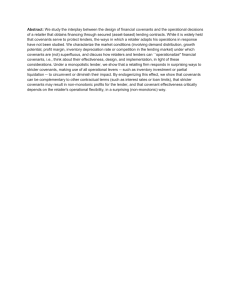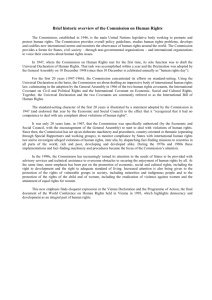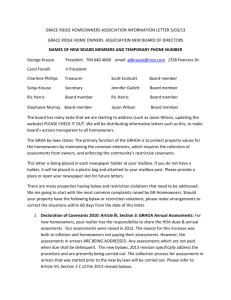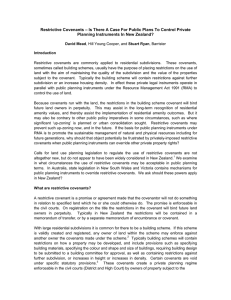DESIGN REVIEW CRITERIA In reviewing applications for
advertisement
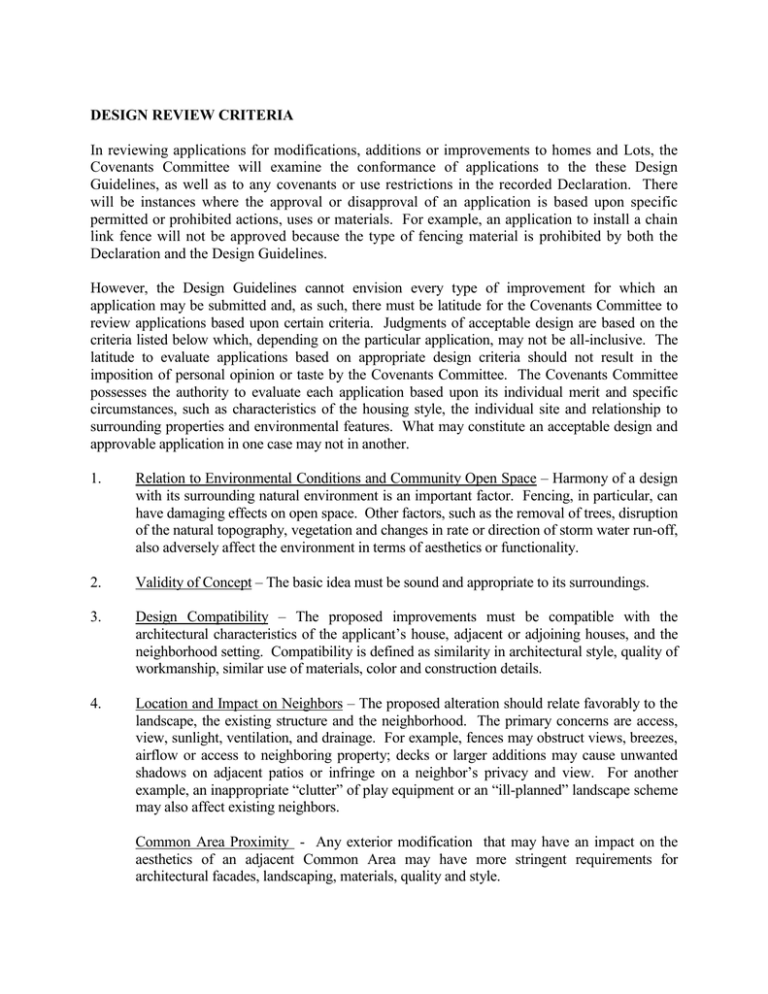
DESIGN REVIEW CRITERIA In reviewing applications for modifications, additions or improvements to homes and Lots, the Covenants Committee will examine the conformance of applications to the these Design Guidelines, as well as to any covenants or use restrictions in the recorded Declaration. There will be instances where the approval or disapproval of an application is based upon specific permitted or prohibited actions, uses or materials. For example, an application to install a chain link fence will not be approved because the type of fencing material is prohibited by both the Declaration and the Design Guidelines. However, the Design Guidelines cannot envision every type of improvement for which an application may be submitted and, as such, there must be latitude for the Covenants Committee to review applications based upon certain criteria. Judgments of acceptable design are based on the criteria listed below which, depending on the particular application, may not be all-inclusive. The latitude to evaluate applications based on appropriate design criteria should not result in the imposition of personal opinion or taste by the Covenants Committee. The Covenants Committee possesses the authority to evaluate each application based upon its individual merit and specific circumstances, such as characteristics of the housing style, the individual site and relationship to surrounding properties and environmental features. What may constitute an acceptable design and approvable application in one case may not in another. 1. Relation to Environmental Conditions and Community Open Space – Harmony of a design with its surrounding natural environment is an important factor. Fencing, in particular, can have damaging effects on open space. Other factors, such as the removal of trees, disruption of the natural topography, vegetation and changes in rate or direction of storm water run-off, also adversely affect the environment in terms of aesthetics or functionality. 2. Validity of Concept – The basic idea must be sound and appropriate to its surroundings. 3. Design Compatibility – The proposed improvements must be compatible with the architectural characteristics of the applicant’s house, adjacent or adjoining houses, and the neighborhood setting. Compatibility is defined as similarity in architectural style, quality of workmanship, similar use of materials, color and construction details. 4. Location and Impact on Neighbors – The proposed alteration should relate favorably to the landscape, the existing structure and the neighborhood. The primary concerns are access, view, sunlight, ventilation, and drainage. For example, fences may obstruct views, breezes, airflow or access to neighboring property; decks or larger additions may cause unwanted shadows on adjacent patios or infringe on a neighbor’s privacy and view. For another example, an inappropriate “clutter” of play equipment or an “ill-planned” landscape scheme may also affect existing neighbors. Common Area Proximity - Any exterior modification that may have an impact on the aesthetics of an adjacent Common Area may have more stringent requirements for architectural facades, landscaping, materials, quality and style. 5. Scale – The size (in three dimensions) of the proposed alteration should relate well to adjacent structures and its surrounds. For example, a large addition to a small house may be inappropriate. 6. Color – Color may be used to soften or intensify visual impact. Parts of an addition that are similar in design to an existing house, such as roofs and trim, should match in color and composition. A sample board of exterior materials, finishes, and colors may be required at the sole discretion of the Covenants Committee. 7. Materials – Continuity is established by use of the same or compatible materials as were used in the original house. The options may be limited somewhat by the design and materials of the original house. 8. Workmanship – The quality of work should be equal to, or better than, that of the surrounding area. Poor practices, besides causing the owner problems, can be visually objectionable. By approving an application, the Brambleton Community Association, Board and the Committee assume no responsibility for the safety, structural integrity, quality or workmanship of any new construction. It is the responsibility of each applicant to obtain a Building Permit where required and comply with Loudoun County codes and regulations. 9. Timing – Projects that remain incomplete for long periods of time are visually objectionable and can be a nuisance and safety hazard for neighbors and community. Article 9.5(b)(1) of the Declaration states: “Any Person obtaining approval of the Covenants Committee shall commence construction or alteration in accordance with plans and specifications approved within six months after the date of approval and shall substantially complete any construction or alteration within twelve months after the date of approval or within such other period as specified in the approval. Notwithstanding the foregoing, the approval may provide for a different period during which to commence or complete construction. If any such Person does not complete the work within twelve months after approval, or such other time period determined by the Covenants Committee, the approval shall lapse and be considered a violation. The Association will rely on the Enforcement Procedures to correct the violation.” 10. Site Appearance – A daily clean-up of project waste materials is necessary, including the orderly stacking and storage of all construction materials/supplies out of sight. No longterm accumulation of materials may be stored in a location Visible from Neighboring Property. Materials are to be stored out of view.

